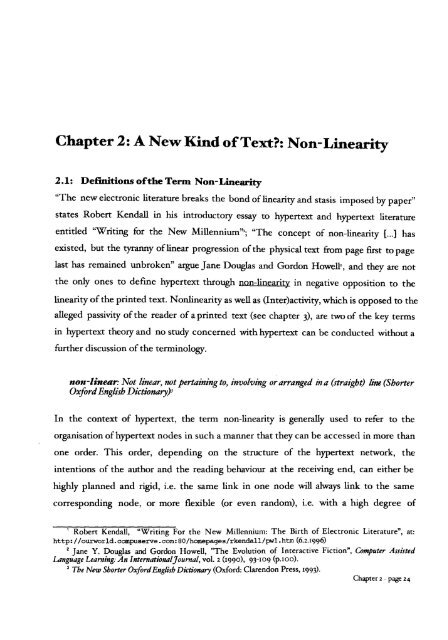From Page to Screen - WRAP: Warwick Research Archive Portal ...
From Page to Screen - WRAP: Warwick Research Archive Portal ...
From Page to Screen - WRAP: Warwick Research Archive Portal ...
You also want an ePaper? Increase the reach of your titles
YUMPU automatically turns print PDFs into web optimized ePapers that Google loves.
Chapter 2: A New Kind ofText?: Non-Linearity<br />
2.1: Definitions ofthe Term Non-Linearity<br />
"The new electronic literature breaks the bond oflinearity and stasis imposed by paper"<br />
states Robert Kendall in his introduc<strong>to</strong>ry essay <strong>to</strong> hypertext and hypertext literature<br />
entitled "Writing for the New Millennium". "The concept of non-linearity {...) has<br />
existed, but the tyranny oflinear progression ofthe physical text from page first <strong>to</strong> page<br />
last has remained unbroken" argue Jane Douglas and Gordon Howell', and they are not<br />
the only ones <strong>to</strong> define hypertext through non-linearity in negative opposition <strong>to</strong> the<br />
linearity ofthe printed text. Nonlinearity as well as (Inter)activity, which is opposed <strong>to</strong> the<br />
alleged passivity ofthe reader of a printed text (see chapter 3), are two of the key terms<br />
in hypertext theory and no study concerned with hypertext can be conducted without a<br />
further discussion ofthe terminology.<br />
non-linear: Not linear, not pertaining<strong>to</strong>, involving orarranged ina (straight) line (Shorter<br />
OxfordEnglish Dictionary)'<br />
In the context of hypertext, the term non-linearity is generally used <strong>to</strong> refer <strong>to</strong> the<br />
organisation ofhypertext nodes in such a manner that they can be accessed in more than<br />
one order. This order, depending on the structure of the hypertext network, the<br />
intentions of the author and the reading behaviour at the receiving end, can either be<br />
highly planned and rigid, i.e. the same link in one node will always link <strong>to</strong> the same<br />
corresponding node, or more flexible (or even random), i.e. with a high degree of<br />
1 Robert Kendall, "Writing For the New Millennium: The Birth of Electronic Literature", at:<br />
http://ourworld.compuserve.com:80/homepages/rkendall/pwl.htm (6.2.1996)<br />
2 Jane Y. Douglas and Gordon Howell, "The Evolution of Interactive Fiction", Computer Assisted<br />
Language Learning: An lntemationai[ournal, vol. 2 (1990), 93-109 (p.100).<br />
3 The New Shorter OxfordEnglish Dictionary (Oxford: Clarendon Press, 1993).<br />
Chapter 2 - page24





